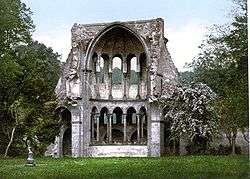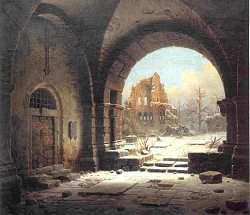Heisterbach Abbey
Heisterbach Abbey (Kloster Heisterbach; also Petersthal, formerly Petersberg) was a Cistercian monastery in the Siebengebirge near Oberdollendorf in North Rhine-Westphalia, Germany.

Petersberg
The tradition of its origin is that a knight named Walther lived as a hermit on the Stromberg, also known as the Petersberg, one of the mountains forming the Siebengebirge. When numerous disciples began to settle near his cell, he built a monastery in 1134, where the community lived according to the Rule of St. Augustine. After the death of Walther however his disciples left the monastery on the Petersberg and built another on the Sulz.
In 1189 Philip, Archbishop of Cologne, requested Gisilbert, abbot of the Cistercian Himmerod Abbey in the Bishopric of Trier, to re-settle the deserted monastery of Petersberg with Cistercians from Himmerod. On 22 March 1189, therefore, twelve Cistercian monks with the newly appointed Abbot Hermann took possession of it.

Heisterbach
Three or four years later they moved to the foot of the mountain, where they built a new monastery which they called Petersthal or Heisterbach, which was the name which prevailed.
The famous basilica of Heisterbach was begun by Abbot Gerard (1195–1208), and consecrated in 1237 under Abbot Henry (1208–1244). Being built during the period of transition from the Romanesque round arch to the Gothic pointed arch, its style of architecture was a combination of the Romanesque and the Gothic.
Heisterbach, which had large possessions and drew revenues from many neighbouring towns, remained one of the most flourishing Cistercian monasteries until its suppression in 1803. The library and the archives were given to the city of Düsseldorf; the monastery and the church were sold and torn down in 1809, and only the apse with the ruins of the choir remains.
Caesarius of Heisterbach
Caesarius of Heisterbach, one of the best-known members of the Cistercian Order, was a monk at this abbey (1199–c. 1240). A monument was erected in his honour near the ruins in 1897.
External links
| Wikimedia Commons has media related to Kloster Heisterbach. |
![]()
Literature
- Caesarius von Heisterbach: Dialogus Miraculorum – Dialog über die Wunder. Nikolaus Nösges and Horst Schneider eds.,5 vols. Latin and German. Brepols Publishers, Turnhout 2009, ISBN 978-2-503-52940-0